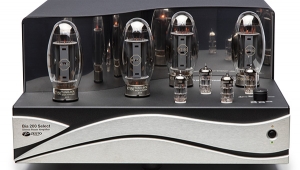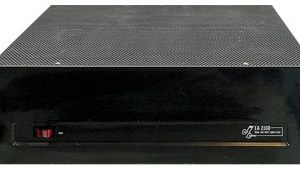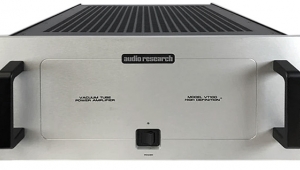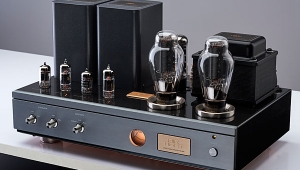| Columns Retired Columns & Blogs |
Kora Electronic Cosmos monoblock power amplifier
"Moi? You want moi to review a French audio product?"
The phone call shocked me—a brickwall SFP (Scull French-Pass) filter usually restricts the flow of such products from moving beyond Jonathan Scull's JMlab-guarded gates. But here was Stereophile's senior editor making me the offer.

"YBA pig about it?" he acknowledged. "Franc-ly, I'd never have assigned it to you, but I've got some bigger fish to French fry this month."
De Gaulle of da guy!
A few weeks later, after clearing customs, two large, battered cardboard containers arrived looking like whatever was inside couldn't possibly have survived intact. But they had, thanks to double boxing, and I quickly unpacked and tubed the surprisingly compact, stylish Kora Electronic Concept Cosmos monoblock amps—but not before noting what I thought was their less than Grande Cru Classe chassis of folded and screwed-together sheet metal.
Kinda thin, I thought, figuring these powerful amps would go for at least $10,000/pair.
Removing each amplifier's protective cage to install the tubes proved frustrating: the eight hex-head bolts securing the cage sit too close to it for a 90 degree Allen wrench to turn 360 degrees, so it was half a turn at a time—no fun when you have to do it 16 times. Once each cage was off, the chromed frame around the tubes slid off, spilling eight hitherto unsuspected washers onto the floor. What's the deal here? I thought as I inserted the tubes into the symmetrically positioned sockets on each chassis.
Then it was time to line up the chrome frames, position a washer over each of the eight screw holes, and affix the cage with the Allen wrench—a half turn at a time. Then the same for the other channel. You can leave the cages off and just screw down the chrome frames, but, aware of what sometimes falls off of shelves here, and of the possibility that one or more of our four Bernese Mountain Dogs might pay a visit, I played it safe and caged them (the amps, not the dogs).
Sure hope these things sound like 10 grand, I thought, because they're sure not built to a 10 grand standard—not on the outside, anyway.
Only after a few weeks of serious listening did I find out that the Cosmos sell for a surprisingly reasonable $4795. That's for the pair. As of January 2002, the price goes up to $5500—still enticing for a pair of 100W, fully balanced, class-A triode monoblocks.
Solid to the Kora
I wasn't familiar with Kora E.C., an 11-year-old company based in Toulouse, France. Kora was founded by a group of young engineers to specialize in power supplies and signal treatments for the French Aerospatiale complex at Toulouse, France's version of Silicon Valley. Per the Kora website: "A public, scientific, and technical establishment with both industrial and commercial responsibilities, ONERA reports to the French Ministry of Defense and enjoys financial independence."
The Kora team evidently got bored with the power-supply cash cow, so to add some drama to the balance sheet, the music-loving entrepreneurs commenced designing and building vacuum-tube amplifiers. The Design 30 integrated was their first tubed commercial release, in 1994. Designer François Philibert used MOSFETs to stabilize the power supply, but the rest of the circuit was tubes. Other tube amps followed, including the Design 50, which used a unique Constant Power System said to allow the amplifier to correct for variations in speaker impedance. That innovation is included in the Electronic Concept Cosmos as well.
By 1998, Kora had added a D/A converter, a preamplifier, and a new series of stereo and monoblock power amps. The Cosmos was introduced at the 1999 Las Vegas WCES, along with a number of other tube amplifiers.
Cosmos Design Basics
The fully balanced Cosmos uses eight Sovtek or Svetlana 6AS7G dual-triode output tubes (the review sample was fitted with the latter), and, as drivers, four Sovtek EL84Ms and two JAN Philips 6922s. The Kora-designed output transformers (optimized for 3-12 ohm speakers and spec'd for 200W) and the power transformer are neatly tucked out of sight under the chassis top plate. Comparative Signal Correction (CSC), a dynamic feedback circuit that parallels the signal path, compares the output signal with the input. According to Kora, unlike constant-feedback circuits, CSC applies feedback only if input/output differences are detected. Thus, claims Kora, one gets the signal-control benefits of feedback and the dynamic, lively, detailed sound of zero-feedback designs.
The 6AS7G is a venerable dual-triode tube based on the 6B4 single-triode, itself an updated version of the 2A3—the tube that gets the single-ended crowd all tingly. Reliable, durable, inexpensive, and not too fussy about biasing (according to a Kora spokesperson), the 6AS7G would seem to be the kind of glassware you'd want in an application that requires no fewer than 16 tubes for two channels. Kora supplies the tubes in matched sets, each tube numbered for its intended socket. Each output tube is fused; should a fuse blow, an LED next to it glows red. Accessing the fuse holders requires removal of the cage and the aforementioned chrome frame. Feh.
Use
I first placed each Electronic Concept Cosmos on a Grand Prix Audio amp stand, and used the two large rear-mounted rubber feet and the single front-mounted cone to level the amp (the rear underside of the chassis protrudes down a few inches to accommodate the transformers). The rear panel includes a fused IEC AC jack, balanced XLR and unbalanced RCA inputs and selector switch, WBT speaker terminals, and a convenient "ground lift" switch. The On/Off switch is uncomfortably close to the AC jack—not the most convenient location, but it probably saved some money and kept all of the incoming AC circuitry in one place.
Fortunately, using the Cosmoses was as easy as turning them on. Unfortunately, I didn't have a balanced preamp; I ran them single-ended, which might not have maximizes their power output or signal/noise ratio.
That Fabulous Tube Sound
Audiophiles don't opt for tube amps to watch them glow (well, maybe a few do). They crave a certain musical pulchritude that only tubes deliver, even if accompanied by thoroughly mediocre measurements. I heard that lovely sound when I reviewed the seductive KR VT8000 MK monoblock in November 1999, and I'll never forget the first time I read the miserable set of measurements that accompanied my rave. Based on John Atkinson's test-bench figures, that two-tube hybrid design fell flat on its face. Listening was another story.
I have no idea how the Kora Cosmos will measure up to JA's tests, but Kora claims 100Wpc into 6 ohms, a bandwidth of 7Hz-50kHz, -3dB, and harmonic distortion of 0.07% at 1W and 0.3% at 50W. Pretty good numbers for a tube amp.
But whatever specs these former power-supply gurus deliver, the sound their Cosmoses served up was, in most respects, the most enticing I've heard in my home.
The first LP I listened to was Junior Wells' Southside Blues Jam (Delmark DS-628), with Buddy Guy, Louis Myers, and Otis Spann in his last studio recording. The raw sound of this record, taped live in the studio, exploded from the Audio Physic Avanti IIIs with thrilling and somewhat surprising purity, transparency, and, most notably, breathtaking palpability. The sensations of musical "feel" and "touch" were communicated with almost alarming immediacy.
I never had to warm up to the Koras—before I even began to analyze what was going on, my reaction was already a broad smile and an audible "Wow!" Nothing wimpy about the presentation, either. Arrayed before me were well-focused three-dimensional images, some of them protruding farther out into the room than I was accustomed to, with an equally well-developed expression of depth behind the speakers. Nor could the dynamics be faulted—the Cosmoses sounded as if they were coasting, with plenty of power to spare.
From that first LP and throughout the too-short review period (though it was the usual length of time), the Kora Cosmos rendered the treble presentation I crave: sharp, extended, and fast, yet without an etch, mechanicalness, or brightness that might have dissociated itself from the overall musical presentation. In other words, the Kora Cosmos delivered effortlessly everything I'd worked so hard to coax from the Audio Research VTM200 last January but could not.
Writing that VTM200 review wasn't easy. I took some heat for it from a few readers, and from another reviewer—in Audio Research's room at the 2001 CES. But had I glossed over the top-end problems I heard from the ARC, where would that have left me once I'd heard what the Koras were able to do in the same area? (Veteran reviewer Martin Colloms reached conclusions similar to mine in his review of the VTM200, published in Hi-Fi News some time after mine appeared in Stereophile).
Drummer Fred Below's cymbals on that Junior Wells LP had the combination of crisp ring, fat metallic shimmer, and detailed decay that just drives me crazy. More important, it sounds like live music. Some listeners are bass freaks, but I'd be willing to give up some bottom-end authority to get what the Koras presented on top. Guy's guitar strings had just the right edge and stridency to deliver his slashing message, yet the warm, tubey guitar amp he was obviously playing through blossomed below.
I could probably spend another few pages on the magic the Koras pulled from that record, but while I was in my collection's blues neighborhood, I happened on Clarence "Gatemouth" Brown Sings Louis Jordan, on an appropriately French label (Disques Black and Blue 33.053). There's no date, and all the writing is in French (What's the matter with these people? Don't they speak English?), but I'd say the Black and Blue recording was from the 1970s, so it's all analog and stereo.
Backed by a small combo of tenor sax, organ, and bass, Brown rocks his way through such Jordan jump classics as "Caldonia" and "Is You Is or Is You Ain't My Baby." The Koras proved they could match the speed and rhythmic agility of my reference Musical Fidelity Nu-Vista 300, while rendering the organ with a more supple and juicy feel.
To check out orchestral sound, I pulled out an original pressing of Fritz Reiner and the CSO's interpretation of Stravinsky's Song of the Nightingale, the oft-neglected flip side of Prokofiev's Lieutenant Kijé on RCA LSC-2150. But from listening to that Junior Wells LP, I already knew what I'd find. The dense, explosive opening, packed with percussion, flutes, bells, staccato brass, and furious strings, can often sound congested, bright, and harmonically parched. The Koras delivered it with utter grace. There was both spatial and textural separation, the flutes sounding appropriately breathy, the bells "chimey," the strings delicate and sonorous. The picture never turned hard, but the instruments within the picture did when that was appropriate. The overall presentation was positively dazzling.
- Log in or register to post comments



































